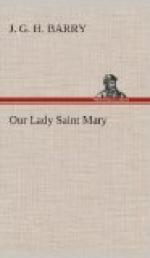It we would understand the Old Testament we must find that its intimate note is preparation, just as the intimate note of the New Testament is accomplishment. God is working to a foreseen end, and is working as fast as men will consent to co-operate and become the instruments of His purpose. The purpose is not one that can be achieved by the exercise of power; it is a purpose of love and can be effected only through co-operating love. And as we watch the final unfolding of that purpose in the Incarnation of God, we more and more become conscious of the preparation of all the instruments of the purpose which are working in harmony for the revelation of the meaning of God.
Of all the instruments of this divine purpose, one figure has preeminently fascinated the devout imagination because of her unique beauty, and has been the object of profound speculation because of the intimacy of her relation to God,—Mary of Nazareth. The vocabulary of love and reverence has exhausted itself in the attempt to express our estimate of her. The literature of Mariology is immense. And no one who has at all entered into the meaning of the Incarnation, of what is involved in eternal God taking human flesh, can wonder at this. Here at the crisis of the divine redeeming action, when the crowning mystery which angels desire to look into is being accomplished, we find the figure of a village maiden of Israel as the surprising instrument of the advent of God. We wonder: and we instinctively feel, that as all the other steps and instruments in God’s redemption of man had from the beginning been carefully prepared, so shall we find preparation here. We understand that as God could not come in the flesh at any time, but only when the “fulness of time” had come; so He could not come of any woman, but only of such an one as He had prepared to be the instrument of His Incarnation.




